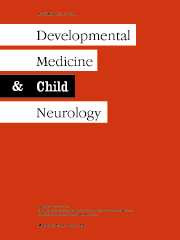Article contents
Correlative value of magnetic resonance imaging for neurodevelopmental outcome in periventricular leukomalacia
Published online by Cambridge University Press: 28 October 2004
Abstract
The aim of this study was to evaluate the correlative value of magnetic resonance imaging (MRI) in children with periventricular leukomalacia (PVL) for neurodevelopmental outcome. MRI examinations of 89 children (46 males, 43 females) with PVL (median age 4y, range 1 to 14y) were reevaluated. PVL was graded as follows: grade I, unilateral or bilateral areas of periventricular hyperintensity (1–3); grade II, hyperintensity more than 3; grade III, hyperintense lesions more than 3 and ventricular wall irregularity; grade IV, diffuse PVL and ventricular dilatation. Localizations of PVL and brain abnormalities associated with PVL were also noted. Assignment to PVL grades on MRI was as follows: PVL I (n=22), PVL II (n=18), PVL III (n=30), and PVL IV (n=19). Cerebral palsy was slightly less common in children with PVL I and II compared with PVL III to IV. Motor function was normal in 50% of children with PVL grade I, but severely impaired in 73.7% of children with PVL grade IV. Results of visual function were normal in all with PVL I, but pathological in 42.1% of patients with PVL IV. Developmental tests were appropriate for age in 75% of patients with PVL I, but significantly delayed in all patients with PVL IV. Thinning of the corpus callosum and presence of cortical atrophy were also correlated with neurological outcome. Significant risk factors associated with developmental delay were asphyxia at birth (odds ratio [OR] 4.3), PVL localization numbers over 3 (OR 4.4), PVL III to IV (OR 15), thinning of corpus callosum, and cortical atrophy.
- Type
- Original Articles
- Information
- Copyright
- © 2004 Mac Keith Press
- 3
- Cited by




